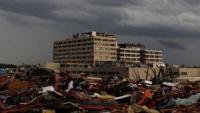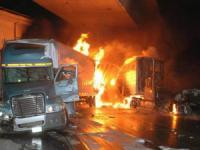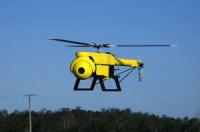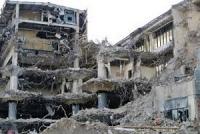-
Keeping first responders, high-risk workers safer
Researchers have created a motion-powered, fireproof sensor that can track the movements of firefighters, steelworkers, miners and others who work in high-risk environments where they cannot always be seen.
-
-
Smart sensor to enhance emergency communications
First responders run toward danger; their jobs require it. Often, their only connection to the outside world during these rescue missions is their colleagues at the command centers who coordinate the rescue effort. with the ubiquity of IoT devices now, first responders have access to a vast, timely, and smart network of connections to the outside world.
-
-
Dealing with disaster

It took less than 90 minutes before students in Miaki Ishii’s first-year seminar started to talk openly about revolt. The unrest, however, wasn’t due to any political issue currently making headlines, but to a small room in Harvard’s Geological Museum and a handful of their classmates. The students took part in a role-playing game that saw them acting as citizens of the island of Montserrat, the tiny country’s government, and a group of scientists monitoring the island’s volcano. Why revolt? Because the students soon grew skeptical of the government’s ability to quickly and effectively respond to pressing environmental concerns.
-
-
Basic safety measures will save lives in tunnels

What has to happen to facilitate more effective rescues from tunnel fires? Researchers have been investigating how eighty research subjects wearing VR glasses reacted in a virtual tunnel fire. Their conclusion is that basic measures can save lives.
-
-
Autonomous drones can help search and rescue after disasters

When disasters happen – whether a natural disaster like a flood or earthquake, or a human-caused one like a mass shooting or bombing – it can be extremely dangerous to send first responders in, even though there are people who badly need help. Drones are useful, and are helping in the recovery after the deadly Alabama tornadoes, but most require individual pilots, who fly the unmanned aircraft by remote control. Autonomous drones could cover more ground more quickly, but would only be more effective if they were able on their own to help rescuers identify people in need.
-
-
Keeping the lights on during and after a disaster

The threat of an inevitable earthquake is the uncomfortable truth we all face in the Cascadia Subduction Zone, which stretches from Alaska to California. Because the last major earthquake in the area was in the 1700s, our infrastructure developed without an appreciation and understanding of earthquake resilience. That means the next major earthquake will likely devastate our buildings, roads, bridges, and utility providers, posing immediate risks for the health and safety of those who live in the region. And later, there will be long-term economic aftershocks.
-
-
Using data utilization to augment community resilience, disaster response
A civil engineering who researches resilience against extreme events and natural hazards is responding to lessons learned from California’s deadly Camp Fire by outlining how to utilize the power of data to improve disaster response and minimize economic loss and human harm in similar events.
-
-
VitalTag to give vital information in mass casualty incidents
When mass casualty incidents occur — shootings, earthquakes, multiple car pile ups — first responders can easily be overwhelmed by the sheer number of victims. When every second counts, monitoring all the victims in a chaotic situation can be difficult. Researchers developed a stick-on sensor that measures and tracks a patient’s vital signs to help first responders quickly triage, treat and transport the injured.
-
-
Foldable drone flies through narrow passages in rescue missions
Researchers have developed a new drone that can retract its propeller arms in flight and make itself small to fit through narrow gaps and holes. This is particularly useful when searching for victims of natural disasters.
-
-
Responders provide technical expertise in case of nuclear weapons accidents
Decades ago, technical experts from the national labs responded in an ad hoc manner to accidents involving nuclear weapons, called “broken arrows.” Thirty-two such accidents have occurred since the 1950s, so the Accident Response Group at Sandia Lab was created about five decades ago to provide technical expertise in assessing and safely resolving nuclear weapons accidents.
-
-
Israeli device that extracts water from the air helps California firefighters quench thirst
An emergency response vehicle (ERV) carrying an innovative Israeli machine that pulls drinking water out of ambient air is on its way to California to provide hydration to police and firefighters dealing with the aftermath of two massive wildfires that have taken at least eighty-seven lives.
-
-
Fleets of drones could aid searches for lost hikers
Finding lost hikers in forests can be a difficult and lengthy process, as helicopters and drones can’t get a glimpse through the thick tree canopy. Recently, it’s been proposed that autonomous drones, which can bob and weave through trees, could aid these searches. But the GPS signals used to guide the aircraft can be unreliable or nonexistent in forest environments. New system allows drones to cooperatively explore terrain under thick forest canopies where GPS signals are unreliable.
-
-
Making Oregon safer in quakes and fires
Research by University of Oregon seismologist is shaping a new set of policy agendas designed to help Oregon prepare for a Cascadia earthquake and other natural disasters. His work on the ShakeAlert earthquake early warning system and its companion multihazard monitoring efforts informed Oregon Gov. Kate Brown’s just-released document, “Resiliency 2025: Improving Our Readiness for the Cascadia Earthquake and Tsunami.”
-
-
More than 1,000 stakeholders join N.Y.-N.J. Metropolitan Resilience Network
An innovative program, the Metropolitan Resilience Network (MRN), now has over 1,000 credentialed stakeholders from hundreds of public and private organizations in the New York metro area. MRN members are connected and collaborating on shared threats to the region through a unique technology platform as well as a wider spectrum of activities.
-
-
Florida Panhandle counties less prepared for emergency than rest of state
found that the vast majority of counties in the Florida Panhandle were less prepared for emergency evacuation compared to the rest of the state. Of the 67 counties in Florida, 10 were rated as having weak levels of evacuation preparedness, and all of these counties were located in the Panhandle/North Florida. Eleven of 16 counties with moderately rated plans also were in this region. Only seven of the counties in the Panhandle had strong plans.
-
More headlines
The long view
The Surprising Reasons Floods and Other Disasters Are Deadlier at Night
It’s not just that it’s dark and people are asleep. Urban sprawl, confirmation bias, and other factors can play a role.
Why Flash Flood Warnings Will Continue to Go Unheeded
Experts say local education and community support are key to conveying risk.
